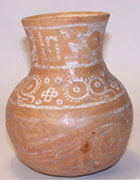Ancient Mexican artifacts donated to WFU Museum of Anthropology
Hundreds of earthenware pots and other pre-Columbian artifacts from ancient West Mexico are now part of the collections of Wake Forest University’s Museum of Anthropology.

Decorated jar from Nayarit or Jalisco cultures, 300BC-AD 300.
The objects, most dating from 300 B.C. to 400 A.D., were donated to the museum in May. The collection of 1,040 pieces includes 162 complete ceramic vessels, ceramic figurines, greenstone beads and necklaces, obsidian spear and arrow points, knives and grinding stones.
“The collection allows us to design exhibits based on ancient Mexico that we were not able to do before,” said Stephen Whittington, director of the museum.
Many of the bowls and pots are already on display in the museum. The decorated ceramics were used in feasting rituals and held burial offerings for the dead. Some of the featured pottery includes dog images that may represent underworld guides for the souls of the dead.
The artifacts are from ancient tombs in West Mexico (in the modern states of Nayarit, Colima, Jalisco, and Michoacan) and from sites in Central Mexico. Pre-Columbian peoples of this region buried their dead in tomb chambers reached by a narrow vertical shaft.

Bowl from Nayarit or Jalisco cultures, 300BC-AD 300.
“These artifacts give us insights into the beliefs people had about what comes after death,” Whittington said. “We don’t know as much about these people as we do about the Aztec and Maya civilizations because there is no written record, but we can recreate with objects what was going on 2,000 years ago.”
The museum offers extensive programs for elementary and middle school students tied to the North Carolina social studies curriculum. Because ancient Latin America is part of the elementary school curriculum, Whittington said the museum staff will look at ways to use the new collection to develop programs for schoolchildren focused on ancient Mexico.
With the new collection, Wake Forest’s anthropology students will have the opportunity to learn more about ancient Mexican cultures.

Effigy bowl, Chupicuaro culture, Michoacan, Mexico 200 BC-AD 200.
“We can take these ceramics and compare them with those made in ancient Europe, Africa or North Carolina and learn about similarities and differences in their decorations, materials and shapes,” Whittington said. “The artifacts will be great for comparative work at the university level.” All of the objects have been photographed and catalogued in the museum’s new digital archive. The archive will be available to the public starting in the fall through a computer station in the museum.
The Museum of Anthropology is located on the campus of Wake Forest University in Winston-Salem. Hours are 10 a.m. Ð 4:30 p.m. Tuesday through Saturday. Admission is free. Call (336) 758-5282 for information and to confirm Saturday hours, which are sometimes reduced durin
Categories: Arts & Culture, Happening at Wake
Media Contact
Cheryl Walker
media@wfu.edu
336.758.5237



